
TOP 5 FAVOURITES AT ICA FESTIVAL 2017
From Graphic Design to Fine Art, here are some of my top favourites at this year’s ICA Festival. For those who haven’t yet heard about the latter, in a nutshell, the ICA Festival was the annual undergraduate degree show which featured work from graduating students across MCAST’s Institute for the Creative Arts (ICA), Mosta. The festival was a five-day event and it was held at the ICA centre from the 30th of June till the 4th of July.
UNTITLED by Emma Grima (BA FINE ART)
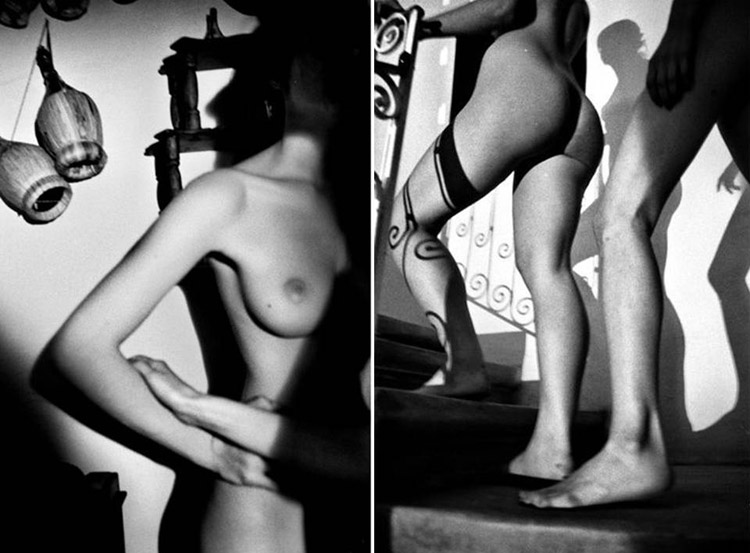
Photo Credit: Emma Grima
Since the popularisation of the camera in the 19th century, fine art nude photography became a favourite genre amongst artists to explore ‘the beauty of the female form’. Grima’s Untitled series contributes to this longstanding tradition. Comprising of seven silver gelatin prints, Untitled represents cropped images of young, desirable female nudes which echo the fetishised nude photographs and film stills of Dada and Surrealist collaborator, Man Ray. Similar, for example, to Man Ray’s Untitled (1924), The Return to Reason (1923), and Shadow Patterns on Lee Miller’s Torso (c.1930) Grima’s photographic captures accentuate the sensuousness of the female form (and leads the viewer’s eye to certain body parts) through the play of light and shadow. Grima’s allusion to Man Ray’s fetishised form of femininity can be interpreted as a counter to male’s objectification of the female body, or in simpler words, to raise questions on how the female body is conventionally perceived as an object for male admiration and contemplation.
Find out more about Emma Grima’s work by clicking on this link https://www.emma-grima.com/
BECOMING by Joanna Portelli (BA FINE ART)
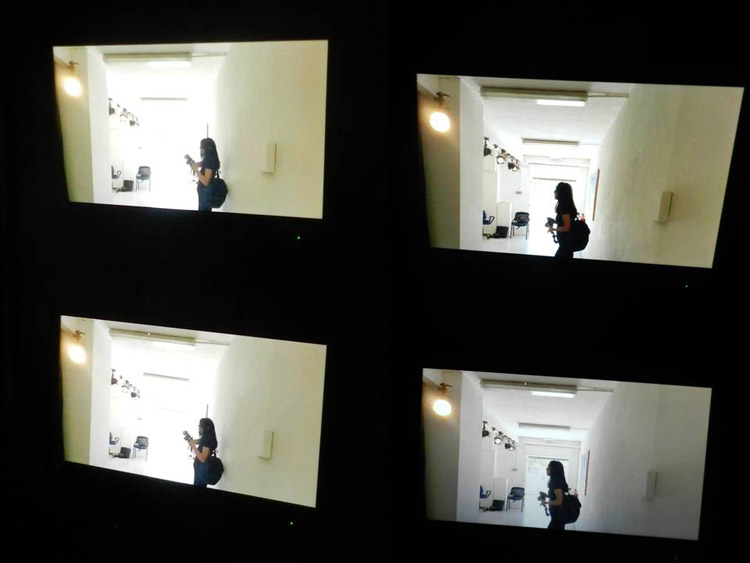
Consisting of three separate art works, or as Portelli explained: “three distinct, yet connected, phases”, this multimedia installation combined traditional painting with video art. Portelli cleverly invited the viewer to enter Becoming‘s main installation space via an oil painting of a woman peeping through a window curtain. Not knowing what to expect (or rather, expecting to see the usual enigmatic, documentary video art) the viewer was confronted by four monitors which featured ‘delayed’ live footages of him/herself. Despite the fact that these footages made the viewer become aware of his/her body and its movements, the reactions that they generated varied. Having experienced the work at first hand, I was initially taken by surprise to see myself plastered on the monitors (picture above). Nonetheless, after a minute or so, I was rather intrigued by how Portelli subtly used ‘me-my body’ as both the subject and the object of the work. Similar to Ilya Kabakov’s 1985 Total Installations, the focus of Portelli’s Becoming is the viewer, the viewer becomes: “The main actor…the main centre towards which everything is addressed, for which everything is intended.”
Find out more about Joanna Portelli’s work by clicking on this link https://www.joanna-portelli.com/
COLLECTIVE UNCONSCIOUS by Kelsey May Connor (BA FINE ART)
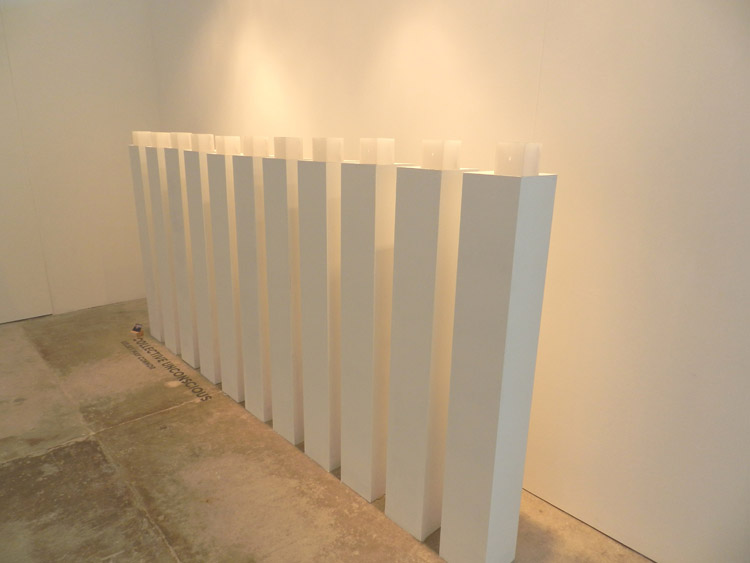
The extreme simplicity of form, the geometrical serial arrangement of the composition, and the use of industrialised material, initially gave me the impression that the work is a Minimalist sculpture installation. Although, as the art historian Daniel Marzona explains: “there is no adequate definition of what should be understood by the term Minimal Art”, anyone acquainted with the 1960s Minimalist works of, for example, Donald Judd and Carl Andre, will notice that, Collective Unconscious defies one of the main concepts that surrounds Judd’s and Andre’s work, and that is: the elimination of the artist’s hand and emotional state of mind. The inclusion of Connor’s hand and emotional state can be attested from the pencil illustrations set inside each cube. Ranging from interior spaces to figurative drawings, these illustrations are visible through tiny peepholes. Although the illustrations are made, as the artist explains, to evoke her “childhood memories and traumatic experiences,” Connor’s peephole-concept brings to mind Samuel Van Hoogstraten’s Interior of a Dutch House (1655-60) and Marcel Duchamp’s Étant Donné(1946-66), in which both artists similarly invite the viewer to look at the their work through tiny holes.
Find our more about Kelsey May Connor’s work by clicking on this link https://www.kelseymayconnor.com/
PINCH by Michaela Fleri Soler (BA GRAPHIC DESIGN + INTERACTIVE MEDIA)
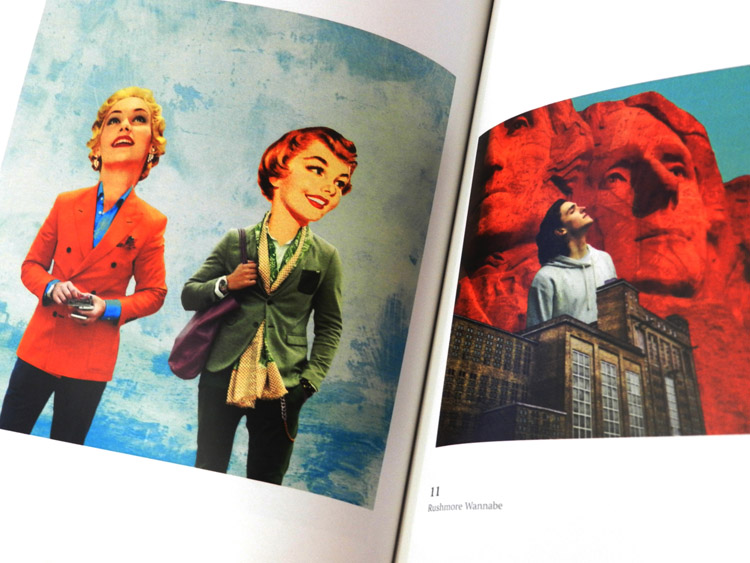
Being a Dada enthusiast, I was pleased to come across Fleri Soler’s Pinch catalogue which illustrates a conjunction of brightly-coloured photomontages. For those who are not familiar with the literary and artistic movement Dada, the photomontage technique was amongst one of [Berlin] Dada’s favourite practices, which they adopted and popularised into a modern avant-garde art form (via periodicals, books, posters and other printed matter) to express political dissent and integrate, in the words of Peter Bürger “art into the praxis of life”. Although Fleri Soler’s photomontages are assembled through digital image editing software, rather than Dada’s cutting and gluing technique, similar to Dada’s paste-ups, Pinch‘s images derive from pre-existing visual sources. By recombining and manipulating other people’s imagery, Fleri Soler imbues Pinch‘s images with new levels of meaning and raises questions of ‘originality, authenticity and authorship’.
Find out more about Michaela Fleri Soler’s work by clicking on this link https://www.behance.net/micflerisoler
SEEK by Joseph Muscat (BA GRAPHIC DESIGN + INTERACTIVE MEDIA)
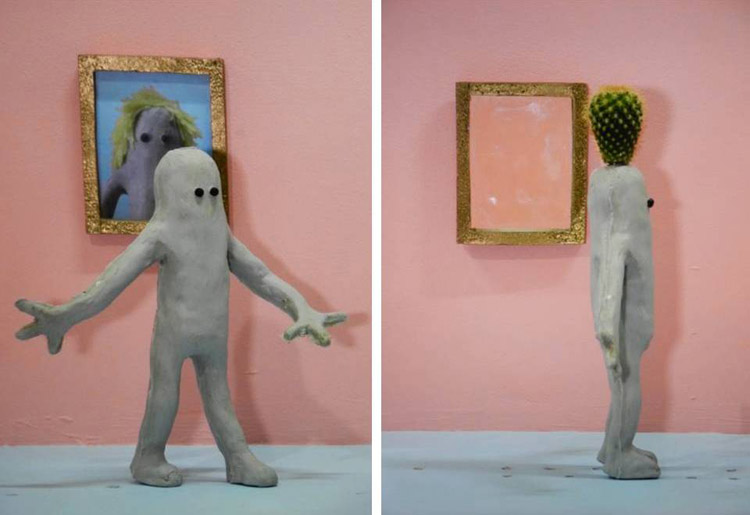
In this two-minute stop-motion animation, Muscat tells the story of a nameless puppet who refrains from conforming to society’s norms of how one should act and look. Unwilling to sport a fancy wig like the rest of his clan, Muscat’s hairless puppet opts to follow his inclinations and place a cactus plant over his head. The moral of SEEK‘s story is that: it’s OKAY to march your own drum and live differently from the norm. Cast in silicone, Muscat’s handcrafted puppets find their roots in Kirsten Lepore’s animated stop-motion film Move Mountains, whose main characters bare the same bodily and facial appearance. Although SEEK‘s abstract-looking puppets, and minimalist sugary-hued backdrop, give the impression that SEEK was an easy undertaking, like any other stop-motion animation, SEEK required an inconceivable amount of time (and patience) to produce: every movement of the puppet’s face and posture of his body, for example, had to be animated and shot about 24 times per second.
Find out more about Joseph Muscat’s work by clicking on this link https://www.facebook.com/pg/josephmuscatcreative/about/?ref=page_internal
